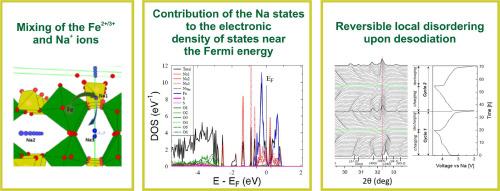Unique properties of the electronic structure of alluaudite sodium iron sulfate cathode material and the impact on its electrochemical performance
IF 9.3
1区 材料科学
Q1 MATERIALS SCIENCE, MULTIDISCIPLINARY
引用次数: 0
Abstract
This work presents the study of the electronic structure of alluaudite-type Na2.5Fe1.75(SO4)3 and its impact on electrochemical performance as a cathode material for sodium-ion batteries (SIBs). Density functional theory calculations using the KKR-CPA method (Korringa–Kohn–Rostoker combined with the coherent potential approximation) revealed the diverse electrochemical activity of sodium ions occupying different sites within the alluaudite framework. Notably, an unprecedented contribution of sodium atoms to the overall electronic density of states near the Fermi level (dominated by Fe-d and O-p states) was observed – a feature not detected in layered transition metal oxide cathodes.
A high-purity Na2.5Fe1.75(SO4)3 cathode material was synthesized via an optimized solid-state route. Using a multi-technique approach – including X-ray diffraction, scanning electron microscopy, Mössbauer spectroscopy, X-ray photoelectron spectroscopy, Fourier-transform infrared spectroscopy, and Raman spectroscopy – the evolution of the electronic structure and electrochemical behavior during sodium (de)intercalation was comprehensively characterized, providing deep insights into the sodium storage mechanism. Operando and in situ X-ray diffraction further tracked structural changes during cycling, showing that the material undergoes a reversible amorphization at deep sodium extraction.
Electrochemical tests demonstrated stable cycling with minimal capacity fade (only 2.5 % after 300 cycles at C/2), highlighting the high structural integrity and promise of this optimized cathode material.


铝矾土硫酸铁钠正极材料电子结构的独特性质及其对其电化学性能的影响
本文研究了冲积型Na2.5Fe1.75(SO4)3作为钠离子电池(SIBs)正极材料的电子结构及其对电化学性能的影响。利用KKR-CPA方法(Korringa-Kohn-Rostoker结合相干电位近似)进行的密度泛函理论计算揭示了冲积岩框架内占据不同位置的钠离子的不同电化学活性。值得注意的是,观察到钠原子对费米能级(以Fe-d和O-p态为主)附近状态的总体电子密度的前所未有的贡献,这是层状过渡金属氧化物阴极中未检测到的特征。采用优化的固态工艺合成了高纯度Na2.5Fe1.75(SO4)3正极材料。利用x射线衍射、扫描电镜、Mössbauer光谱、x射线光电子能谱、傅里叶变换红外光谱、拉曼光谱等多技术手段,全面表征了钠(脱)插层过程中电子结构和电化学行为的演变,为钠的储存机制提供了深入的见解。Operando和原位x射线衍射进一步跟踪了循环过程中的结构变化,表明材料在深钠萃取时经历了可逆的非晶化。电化学测试表明,循环稳定,容量衰减最小(在C/2下循环300次后仅为2.5%),突出了这种优化的阴极材料的高结构完整性和前景。
本文章由计算机程序翻译,如有差异,请以英文原文为准。
求助全文
约1分钟内获得全文
求助全文
来源期刊

Acta Materialia
工程技术-材料科学:综合
CiteScore
16.10
自引率
8.50%
发文量
801
审稿时长
53 days
期刊介绍:
Acta Materialia serves as a platform for publishing full-length, original papers and commissioned overviews that contribute to a profound understanding of the correlation between the processing, structure, and properties of inorganic materials. The journal seeks papers with high impact potential or those that significantly propel the field forward. The scope includes the atomic and molecular arrangements, chemical and electronic structures, and microstructure of materials, focusing on their mechanical or functional behavior across all length scales, including nanostructures.
 求助内容:
求助内容: 应助结果提醒方式:
应助结果提醒方式:


